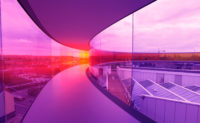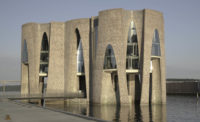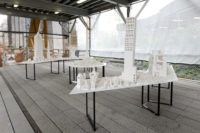For more than a decade, Olafur Eliasson has been making art on a grand scale by recreating the sensory effects of the natural landscape, often inspired by his Icelandic homeland. In the winter of 2003–4, two million visitors to the Tate Modern in London frolicked in, sunbathed under, and marveled at The Weather Project, a giant fake sun made of 200 low-pressure sodium lamps, mirrors, and mist that he installed in the museum’s Turbine Hall. By deploying the most basic lighting technologies to evoke a sublime environment, Eliasson’s creation earned as much critical acclaim as it did popularity.
Since September, the San Francisco Museum of Modern Art has hosted the first American survey devoted to Eliasson. The exhibition, Take Your Time—which will be on view in San Francisco until February 24 and travels to the Museum of Modern Art and P.S. 1 in New York in April, followed by the Dallas Museum of Art—features mostly room-size installations of his work from 1993 to the present, including a kaleidoscopic tunnel commissioned for the building’s fifth-floor indoor bridge. The pieces can seem like sleights of hand, but they capture the viewer’s attention through their simple and evident construction—as if a magician has allowed you to peek into his wardrobe.
Room for One Color has the directness of a simple trick: Plain-as-day sodium lamps mounted on the ceiling of a skinny rectangular room greet you with a disorienting blast of light. The glare from the light is so intense that everyone becomes yellow-and-black polarized versions of themselves, the walls seem to dematerialize, and the overpowering illusion alters the space itself. When you close your eyes, you see purple, yellow’s complementary color. It’s the flipside of The Weather Project, in which you basked in the light; here, you walk quickly out of the oppressive glare. Room for One Color is both a ruse for a show called Take Your Time and an introduction of sorts, signaling that nothing will be what it first appears.
A piece called Beauty is particularly successful at exploding first impressions. In an empty room with black walls, floors, and ceiling, a single Fresnel lamp points at a gentle mist falling from overhead sprinklers. The light produces iridescent, rainbow-like effects as tiny droplets of water diffract it. Because the beam of light has a tight focus, the water appears to change form as it descends, seeming almost solid and sculptural.
Yellow Versus Purple also transforms a seemingly simple optical effect into an environment. A spinning polarized disc hangs in the middle of a small room, rotating as a projector illuminates it. As some of the purple light passes through the disc, other parts of the spectrum are reflected. Yellow light changes shape as the disc rotates—flattening from a circle to a line, then plumping up again—while the purple light moves around the room.
Just as Yellow Versus Purple implicates you in its effect—its reflections pass over the body—Eliasson makes you an integral part of his artwork’s reception. In 360° Room for All Colors, for example, halogen lamps project colors onto the screen of a semicircular room. Slowly moving through the chromatic spectrum, the colors gradually pulse across the screen and saturate the room. With the departure of one color, its complement appears momentarily as an afterimage. The optical illusion is not the work of Eliasson, but of your own eyes’ rods and cones.
Similarly, Reimagine separates sight from perception by suggesting movement. A series of seven incandescent spotlights turn on and off, projecting trapezoidal shapes on a wall. While the effect could be achieved by computer animation, Eliasson uses baffled fixtures with distinct shapes to create the illusion of perspective.
The exhibition’s first as well as final piece requires the most active viewer participation. Walk in one direction through One-Way Color Tunnel and you see only an opaque, metallic structure. But go in the other direction, and it is a translucent, prismatic series of jutting acrylic triangles. Daylight streaming through the prisms changes just as dramatically throughout the multi-sensorial experience. Like most of Eliasson’s work, a very simple setup creates a complex effect, upending perceptions by changing what the viewer sees. And while his construction methods are transparent, he shows the viewer everything but the basic biological mechanisms that transform these devices into transfixing art.




Post a comment to this article
Report Abusive Comment